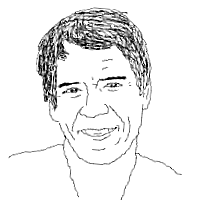 Consciousness, however, does not require language. Nor does it require memory. Or perception of the world, or any action in the world, or emotions, or even attention. So say Christof Koch and Giulio Tononi.
Consciousness, however, does not require language. Nor does it require memory. Or perception of the world, or any action in the world, or emotions, or even attention. So say Christof Koch and Giulio Tononi.
(Koch and Tononi? Sounds an interesting collaboration – besides their own achievements both in the past have been co-authors of grand panjandrums of the field – Koch worked with Francis Crick and Tononi with Gerald Edelman. They have some new ideas here, however.)
I don’t think everyone would agree that consciousness can be stripped down quite as radically as Koch and Tononi suggest. I actually find it rather tricky to get a good intuitive grasp of exactly what it is that’s left when they’ve finished: it seems to be a sort of contentless core of subjectivity. Particular items on the list of exclusions also seem debatable. We know that some unfortunate people are unable to create new memories, for example, but even in their case, they retain knowledge of what’s going on long enough to have reasonable short-term conversations. Could consciousness exist at all if the contents of the mind slid away instantly? Or take action and perception; some would argue that consciousness requires embodiment in a dynamic world; some indeed would argue that consciousness is irreducibly social in character. Again we know that some unlucky people have been isolated from the world by the loss of their senses and their ability to move, without thereby losing consciousness: but these are all people who had perception and action to begin with. Actually Koch and Tononi allow for that point, saying that whether consciousness requires us to have had certain faculties at some stage is another question; they merely assert that ongoing present consciousness doesn’t require them.
 The most surprising of their denials is the denial of attention – some people would come close to saying that consciousness was attention. If there were no perception, no memory , and no attention one begins to wonder how consciousness could have any contents: they couldn’t arrive via the senses; they couldn’t be called up from past experience; and they couldn’t even be generated by concentrating on oneself or the surrounding nullity.
The most surprising of their denials is the denial of attention – some people would come close to saying that consciousness was attention. If there were no perception, no memory , and no attention one begins to wonder how consciousness could have any contents: they couldn’t arrive via the senses; they couldn’t be called up from past experience; and they couldn’t even be generated by concentrating on oneself or the surrounding nullity.
However, let’s not quibble. Consciousness has many meanings and covers a number of related but separable processes. The philosophical convention is that he who propounds the thesis gets to dictate the definitions, so if Koch and Tononi want to discuss a particularly minimal form, they’re fully entitled to do so.
What, then, do they offer as an alternative essence of consciousness? In two words, integrated information. A conscious mind will require many – hugely many – possible states; but, they argue, this is quite different from the case of a digital camera. A 1 megapixel camera has lots of possible states (one for every frame of every possible movie, they suggest – not sure that’s strictly true since some frames will show identical pictures, not that that makes a real difference); but these states are made up of lots of photodiodes whose states are all fully independent, By contrast, states of the mind are indivisible; you can’t choose to see colours without shapes, or experience only the left side of your visual field.
This sounds like an argument that consciousness is not digital but irreducibly analogue, though Koch and Tononi don’t draw that conclusion explicitly, and I don’t think either of them plan to put away their computer simulations. We can, of course, draw a distinction between consciousness itself and the neural mechanisms that support it, so it could be that integrated, analogue conscious experience could be generated by processes which themselves are digital or at least digitizable.
At any rate, they call their theory the Integrated Information Theory (IIT); it suggests, they say, a way of assessing consciousness in a machine, a superior Turing Test (they seem to think the original has been overtaken by the performance of the chatterbot Alice – with due respect to Alice, that seems premature, though I have not personally tried out Alice’s Silver Edition). Their idea is that the candidate should be shown a picture and asked to provide a concise description; human beings will easily recognise, for example, that the picture shows an attempted robbery in a shop and many other details, whereas machines will struggle to provide even the most naive and physical descriptions of what is depicted. This would surely be an effective test, but why does integrated information provide the human facility at work here? It’s a key point about the theory that as well as elements of current experience being integrated into an indivisible whole, current experience is integrated with a whole range of background information: so the human mind can instantly bring into play a lot of knowledge the machine can’t access.
That’s all very well, but this concept of integration is beginning to look less like a simple mechanism and more like a magic trick. Koch and Tononi offer a measure of integrated information, which they call phi: it represents the reduction in uncertainty, expressed in bits, when a system enters a particular state. Interestingly, the idea is that high values of phi correspond with higher levels of consciousness on a continuous scale; so animals are somewhat less conscious than us on average; but it also must be possible to be more conscious than any human to date has ever been: in fact, there is no upper limit in theory to how conscious an entity might be. This is heady stuff which could easily lead on to theology if we’re not careful.
To illustrate this idea of the reduction of uncertainty, the authors compare our old friend the photodiode with a human being (suppose it to be a photodiode with only two states), When the lights go out, the photodiode eliminates the possibility of White, and achieves the certainty of Black. But for the human being, darkness eliminates a huge range of possibilities that you might have been seeing; a red screen, a blue one, a picture of the statue of Liberty, a picture of your child’s piano recital, and so on. So the value of phi, the reduction in uncertainty, for human beings is much vaster than that for the photodiode. Of course measuring phi is not going to be straightforward; Koch and Tononi say that for the moment it can only be done for very simple systems.
That’s fair enough, but one aspect of the argument seems problematic to me. The reduction of uncertainty on this argument seems to be, not vast, but infinite. When the lights went out in your competition with the photodiode, you could have been seeing a picture of one grain of sand; you could have been seeing a picture of two grains of sand, and so on for ever. So it seems the value of phi for all conscious states is infinite. Hang on, though; is even darkness that simple? Remembering that Koch and Tononi’s integration is not limited to current experience, the darkness might cause you to think of what it’s like when you’re about to fall asleep; an unexpected hiatus in the cinema eighteen months ago: a black cat in a coal cellar at midnight. In fact, it might seem like the darkness which enshrouds a single grain of sand; the indefinably bulkier darkness which hides two grains of sand… So don’t both states involve an infinite amount of information, so that the value of phi for all states of consciousness is zero?
I think Koch and Tononi have succeeded in targeting some of the real fundamental problems of consciousness, and made a commendably bold and original attack on them. But they will need a very clear explanation of how their kind of integration works if IIT is really going to fly.

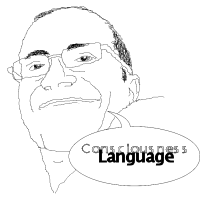 There is clearly a close relationship between consciousness and language. The ability to conduct a conversation is commonly taken as the litmus test of human-style consciousness for both computers and chimpanzees, for example. While the absence of language doesn’t prove the absence of consciousness – not all of our thoughts are in words – the lack of a linguistic capacity seems to close off certain kinds of explicit reflection which form an important part of human cognition. Someone who had no language at all might be conscious, but would they be conscious in quite the same way as a normal, word-mongering human?
There is clearly a close relationship between consciousness and language. The ability to conduct a conversation is commonly taken as the litmus test of human-style consciousness for both computers and chimpanzees, for example. While the absence of language doesn’t prove the absence of consciousness – not all of our thoughts are in words – the lack of a linguistic capacity seems to close off certain kinds of explicit reflection which form an important part of human cognition. Someone who had no language at all might be conscious, but would they be conscious in quite the same way as a normal, word-mongering human?
 I was reading somewhere about SETI and I was struck by the level of confidence the writer seemed to enjoy that we should be able, not only to recognise a signal from some remote aliens, but actually interpret it. It seems to me, on the contrary, that finding the signal is the ‘easy problem’ of alien communication. We might spend much longer trying to work out what they were saying than we did finding the message in the first place. In fact, it seems likely to me that we could never interpret such a signal at all.
I was reading somewhere about SETI and I was struck by the level of confidence the writer seemed to enjoy that we should be able, not only to recognise a signal from some remote aliens, but actually interpret it. It seems to me, on the contrary, that finding the signal is the ‘easy problem’ of alien communication. We might spend much longer trying to work out what they were saying than we did finding the message in the first place. In fact, it seems likely to me that we could never interpret such a signal at all.
 Well, I don’t think anyone underestimates the scope of the task, but you know it can hardly be impossible. For example, we send off a series of binary numbers; binary is so fundamental, yet so different from a random signal, that they would be bound to recognise it. The natural thing for them to do is echo the series back with another term added. Once we’ve got onto exchanging numbers, we send them, like say 640 and 480 over and over. If they’re sophisticated enough to send radio signals, they’re going to recognise we’re trying to send them the dimensions of a 2d array. Or we could go straight to 3D, whatever. Then we can send the bits for a simple image. We might do that Mickey Mouse sort of picture of a water molecule: odds are they’re water-based too, so they are bound to recognise it. We can get quite a conversation on chemistry going, then they can send us images of themselves, we can start matching streams of bits that mean words to streams of bits that mean objects, and we’ll be able to read and understand what they’re writing. OK, it’ll take a long time, granted, because each signal is going to take years to be delivered. But it’s eminently possible.
Well, I don’t think anyone underestimates the scope of the task, but you know it can hardly be impossible. For example, we send off a series of binary numbers; binary is so fundamental, yet so different from a random signal, that they would be bound to recognise it. The natural thing for them to do is echo the series back with another term added. Once we’ve got onto exchanging numbers, we send them, like say 640 and 480 over and over. If they’re sophisticated enough to send radio signals, they’re going to recognise we’re trying to send them the dimensions of a 2d array. Or we could go straight to 3D, whatever. Then we can send the bits for a simple image. We might do that Mickey Mouse sort of picture of a water molecule: odds are they’re water-based too, so they are bound to recognise it. We can get quite a conversation on chemistry going, then they can send us images of themselves, we can start matching streams of bits that mean words to streams of bits that mean objects, and we’ll be able to read and understand what they’re writing. OK, it’ll take a long time, granted, because each signal is going to take years to be delivered. But it’s eminently possible. Knud Thomsen has put a
Knud Thomsen has put a  Jan-Markus Schwindt put up a complex and curious argument against physicalism in a recent JCS: one of those discussions whose course and conclusion seem wildly wrong-headed, but which provoke interesting reflections along the way.
Jan-Markus Schwindt put up a complex and curious argument against physicalism in a recent JCS: one of those discussions whose course and conclusion seem wildly wrong-headed, but which provoke interesting reflections along the way. Benjamin
Benjamin 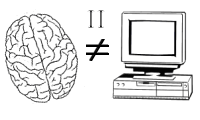 Chris Chatham has gamely
Chris Chatham has gamely Chris Chatham has a nice
Chris Chatham has a nice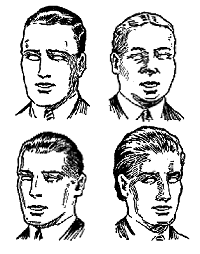 I’ve suggested previously that one of the important features of qualia (the redness of red, the smelliness of Gorgonzola, etc) is haecceity, thisness. When we experience redness, it’s not any Platonic kind of redness, it’s not an idea of redness, it’s
I’ve suggested previously that one of the important features of qualia (the redness of red, the smelliness of Gorgonzola, etc) is haecceity, thisness. When we experience redness, it’s not any Platonic kind of redness, it’s not an idea of redness, it’s 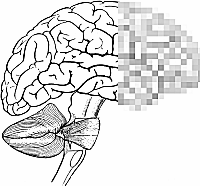 A bit of an
A bit of an